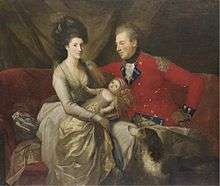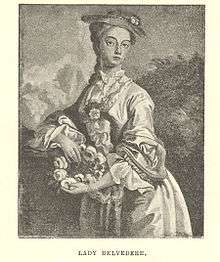George Rochfort, 2nd Earl of Belvedere
| George Augustus Rochfort, 2nd Earl of Belvedere | |
|---|---|
 George Rochfort in volunteer uniform and his second wife, Jane, with baby | |
| Born | 12 October 1738 |
| Died |
13 May 1814 (aged 75) Dublin, Ireland |
| Nationality | British |
| Occupation | Peer, politician |
George Augustus Rochfort, 2nd Earl of Belvedere (12 October 1738 – 13 May 1814) was an Anglo-Irish peer and politician.
Early years

George Augustus Rochfort was born on 12 October 1738, son of Robert Rochfort, 1st Earl of Belvedere and Hon. Mary Molesworth.[1] The Rochfort family, originally called De Rupe Forti, had settled in Ireland in 1243.[2] Sir Maurice de Rochfort was Lord Justice of Ireland in 1302. Gerald Rochfort was summoned to Parliament as a baron in 1339. George's great-grandfather was the prominent lawyer Robert Rochfort, Attorney General of Ireland and Speaker of the House of Commons in 1695, and Lord Chief Baron of the Exchequer in 1707.[3] The family estate of Gaulstown lay on the shore of Lough Ennell in County Westmeath.[4][lower-alpha 1]
George's father, Robert Rochfort, was a favourite courtier of King George II of Great Britain. He was made an Irish peer as Baron of Bellfield in 1737, and then Earl of Belvedere in 1756. He was estranged from his mother for his of his childhood, after his father locked her away after an alleged affair with George's uncle, Arthur.[7]
Politician
From 1756 to 1774 George Rochfort was styled Viscount Belfield. He was Member of Parliament for Philipstown from 1758–61, and Member of Parliament for Westmeath from 1761–1774.[8] The 1761 parliamentary election in County Westmeath followed the death of King George II of Great Britain. George Rochfort, the Right Honorable Lord Belfield, won the election. He was supported by The Honorable Captain Richard Rochfort, Esq. and opposed by Mr. George Rochfort and Gustavus Lambert. The election thus seems to have been very much a family affair. Mr. George Rochfort supported the "Patriots", who demanded that parliaments last only seven years before being dissolved, rather than for the lifetime of the king, as was the custom.[9][lower-alpha 2]
In 1762 George Rochfort was Sheriff of County Westmeath, and from 1772 to 1814 he was a Governor of County Westmeath.[8] An anonymous writer named "Dymoke" published a Review of the House of Commons in the Freeman's Journal in 1774. The purpose was to "rouse the electors of Ireland to a due exertion of their lawful powers, and stimulate them to fix on proper men to maintain their rights and privileges in parliament."[12] He noted that Belfield, who was muster-master-general of Ireland and a Governor of the County of Westmeath, had voted for the stamp act.[13] Dykmore declared that "The present members [Lord Belfield; Anthony Malone] for the County of WESTMEATH will never represent it again, if the Electors have either sense, honour, or remembrance".[14]
Irish peer

On 13 November 1774 Rochfort succeeded to the titles of Baron Belfield, Viscount Belfield and Earl of Belvedere after his father's death.[8] He released his mother.[15] She was prematurely aged, spoke in little more than a whisper but in a harsh, agitated and uneven manner, and was dressed in the style of thirty years earlier.[16]
From 1775–76 Rochfort was Grand Master of the Freemasons Grand Lodge of Ireland.[8] On 20 August 1775 he married Dorothea Bloomfield, daughter of John Bloomfield and Jane Jocelyn.[8] George Rochfort took his mother with him when he and his new wife visited the continent, but she found the travel too difficult. They left her to recuperate in a convent in France while they visited Italy for a few months, spending the winter in Florence. The next year the couple returned to London, where George's mother stayed with a friend in Kensington Palace for a year.[16] She then returned to Ireland and lived first with George in Dublin and then with his sister, now Countess of Lanesborough, and her young family. She died a few years after her husband.[17]
Rochfort had Belvedere House built on Great Denmark Street, Dublin, at the great sum of £24,000.[7] The site had been owned by Nicholas Archdall.[18] The building had been started by the first Earl, with Robert West as architect. Rochfort and his wife apparently did not plan to complete the work, and in 1777 offered it for sale. Later they decided to complete the house for their own use, and gave the job to Michael Stapleton.[19] It was finally completed and occupied in 1786, and probably stood alone at first, since in 1787 Rochfort was recorded as living in North Great George's Street.[20] George's mother is thought to have died there.[7][lower-alpha 3]
During the struggle over the Acts of Union 1800, Rochfort's position on the union of the crowns of Britain and Ireland was uncertain. A letter of 25 January 1800 from Lord Altamont to the Earl of Lucan said "Ld Belvedere has touched Government cash & possibly may not exert all his influence to give value in return for it."[22]
Rochfort's first wife died on 6 April 1803, and on 10 November 1803 he married Jane Mackay, daughter of Reverend James Mackay. They had one son, who died in infancy.[8] George Augustus Rochfort died in Great Denmark Street, Dublin on 13 May 1814 at the age of 75.[3] He is buried in St Sinian, Clonfad Parish Church, of the Church of Ireland. His tomb is adorned with a full-scale neoclassical sculptural group by John Bacon the younger. It represents the earl on his death bed, with his young wife weeping at the end. He is supported by Faith and an angelic figure is beckoning him to heaven.[23]
Rochfort had no surviving children, and his three peerages became extinct.[3] On his death his sister Jane inherited the whole settled part of his great estate, since his brothers had died without children.[24][lower-alpha 4] He left his entire unsettled estate to his wife. This consisted of at least 2,500 Irish acres, bringing in a large income. The fortune was passed down to his wife's children by her second marriage.[24]
References
Notes
- ↑ Jonathan Swift was a close friend of the Rochforts of Gaulstown. It is thought that his Letter to a Very Young Lady on her Marriage (1727) was addressed to the wife of John Rochfort.[5] Swift conceived the idea of Gulliver's Travels (1726) on Lough Ennell. The lake has a park named after the author.[6]
- ↑ The 1861 Westmeath election illustrates the process followed at that time. Polling took place openly in court over an eight-day period from 11–19 May 1761. George Rochfort first declared his principles, but Lord Belfield and Captain Rochfort declined to do so. A voter could vote for more than one candidate, and could be challenged before being allowed to vote. Lord Belfield and Captain Rochfort had 300 friends in town at their expense, while George Rochfort had no more than forty friends, and not at his expense. In the end 606 voters gave 459 votes to Lord Belfield, 343 to his colleague Captain Richard Rochfort, and 259 to their opponent George Rochfort.[10] 272 votes received objections, mostly from Mr. George Rochfort, but most objections were dismissed. Reasons for objection included want of due registry, a technicality, undue influence, insufficiency of freehold or having a papist wife, being a papist or educating his children in the papish religion.[11]
- ↑ There are few records of Mary Rochfort's life after 1774, and she may have never seen Belvedere House in Dublin. However, the legend arose that she haunted that house. James Joyce, who grew up nearby, alluded to the story of the adultery, imprisonment and haunting in Ulysses.[21]
- ↑ George's siblings were Jane (born 30 October 1737), Richard (2 December 1739 – 26 December 1776) and Robert (1743 – December 1772).[2] Jane died in Florence, Italy, in July 1828 at the age of 90, leaving her estate to her grandson, the Earl of Lanesborough.[25]
Citations
- ↑ Burke 1866, p. 457.
- 1 2 Edmondson 1785, p. 285.
- 1 2 3 The Gentleman's Magazine 1814, p. 625.
- ↑ Cullen 1922, p. 167.
- ↑ Hornbeak 1944, p. 183.
- ↑ Davenport 2010, p. 529.
- 1 2 3 Hopkins 2003, p. 21.
- 1 2 3 4 5 6 George Rochfort, 2nd Earl of Belvidere, The Peerage.
- ↑ Woods 1925, p. 24.
- ↑ Woods 1925, p. 26.
- ↑ Woods 1925, p. 27.
- ↑ Kelly & Dymoke 2004, p. 163.
- ↑ Kelly & Dymoke 2004, p. 173.
- ↑ Kelly & Dymoke 2004, p. 209.
- ↑ Belvedere House, Co. Westmeath, Ask About Ireland.
- 1 2 Littell & Littell 1847, p. 124.
- ↑ Littell & Littell 1847, p. 125.
- ↑ Bennett 1991, p. 12.
- ↑ Casey 2005, p. 174.
- ↑ Irish Georgian Society 1969, p. 57.
- ↑ Manglaviti 1999–2000, p. 217.
- ↑ Clesham 2002, p. 27.
- ↑ Casey & Rowan 1993, p. 530.
- 1 2 Malcomson 2006, p. 24.
- ↑ Gentleman's Magazine and Historical Review 1828, p. 82.
Sources
- "Belvedere House, Co. Westmeath". Ask About Ireland. An Chomhairle Leabharlanna. Retrieved 26 June 2014.
- Bennett, Douglas (1991). Encyclopaedia of Dublin. Gill and Macmillan. ISBN 978-0-7171-1599-0. Retrieved 26 June 2014.
- Burke, Bernard (1866). A Genealogical History of the Dormant, Abeyant, Forfeited, and Extinct Peerages of the British Empire. Harrison. Retrieved 26 June 2014.
- Casey, Christine; Rowan, Alistair John (1 January 1993). North Leinster: The Counties of Longford, Louth, Meath and Westmeath. Penguin. ISBN 978-0-14-071085-4. Retrieved 26 June 2014.
- Casey, Christine (2005). Dublin: The City Within the Grand and Royal Canals and the Circular Road with the Phoenix Park. Yale University Press. ISBN 0-300-10923-7. Retrieved 26 June 2014.
- Clesham, Brigid (2002). "Lord Altamont's Letters to Lord Lucan about the Act of Union 1800". Journal of the Galway Archaeological and Historical Society. Galway Archaeological & Historical Society. 54. JSTOR 25573621.
- Cullen, J. B. (April 1922). "Belvedere House. Now St. Francis Xavier's College". The Irish Monthly. Irish Jesuit Province. 50 (586). JSTOR 20505842.
- Davenport, Fionn (2010). Ireland. Lonely Planet. ISBN 978-1-74220-350-8. Retrieved 27 June 2014.
- Kelly, James; Dymoke (2004). "Review of the House of Commons, 1774". Eighteenth-Century Ireland / Iris an dá chultúr. Eighteenth-Century Ireland Society. 19. JSTOR 30071024.
- Littell, Eliakim; Littell, Robert S. (1847). Littell's Living Age. T. H. Carter & Company.
- Edmondson, Joseph (1785). The Present Peerages: With Plates of Arms, and an Introduction to Heraldry ; Together with Several Useful Lists Incident to the Work. J. Dodsley. Retrieved 26 June 2014.
- Gentleman's Magazine and Historical Review. 1828. Retrieved 26 June 2014.
- "George Rochfort, 2nd Earl of Belvidere". The Peerage. Retrieved 26 June 2014.
- Hopkins, Frank (2003). Rare Old Dublin: Heroes, Hawkers & Hoors. Mercier Press Ltd. ISBN 978-1-86023-154-4. Retrieved 26 June 2014.
- Hornbeak, Katherine (February 1944). "Swift's Letter to a Very Young Lady on Her Marriage". Huntington Library Quarterly. University of California Press. 7 (2). JSTOR 3815994.
- Irish Georgian Society (1969). The Georgian Society Records of Eighteenth Century Domestic Architecture and Decoration in Dublin. Society at the Dublin University Press. Retrieved 26 June 2014.
- Malcomson, A. P. W. (2006). The Pursuit of the Heiress: Aristocratic Marriage in Ireland 1740–1840. Ulster Historical Foundation. ISBN 978-1-903688-65-6. Retrieved 26 June 2014.
- Manglaviti, Leo M. (Fall 1999 – Winter 2000). "Sticking to the Jesuits: A Revisit to Belvedere House". James Joyce Quarterly. University of Tulsa. 37 (1/2, Dublin and the Dubliners). JSTOR 25474127.
- The Gentleman's Magazine. 1814. Retrieved 26 June 2014.
- Woods, Thomas (December 1925). "A County Election in 1761". Journal of the County Louth Archaeological Society. County Louth Archaeological and History Society. 6 (1). doi:10.2307/27728212. JSTOR 27728212.
| Peerage of Ireland | ||
|---|---|---|
| Preceded by Robert Rochfort |
Earl of Belvedere 1774–1814 |
Succeeded by Extinct |